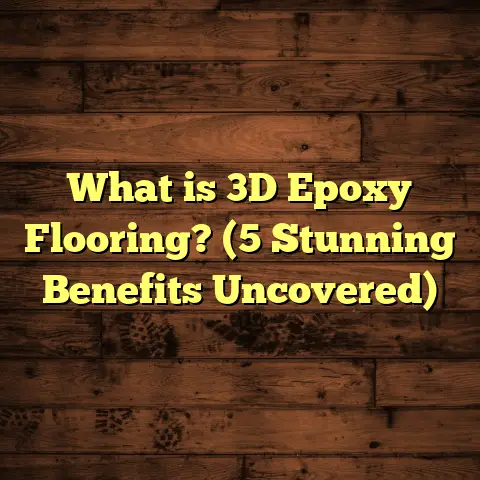What is Ridgewood Flooring? (5 Benefits You Didn’t Know)
Sustainability has really changed how I approach flooring projects nowadays. When I first started out, hardwood floors were the go-to for that classic, warm look. But over time, I saw firsthand how environmental awareness began influencing choices—not just among eco-conscious homeowners but also builders aiming for greener practices. That’s when I started digging deeper into options that offer the beauty of wood but with less environmental impact. Ridgewood Flooring became one of those options that caught my eye and earned a special place in my toolbox. It’s a type of engineered hardwood that many don’t know much about yet, but it offers some surprising benefits.
If you’re like me, curious about sustainable yet stylish flooring options, you might wonder: what exactly is Ridgewood Flooring? What makes it different from other engineered or solid hardwood floors? And could it be the right choice for your home? Over the years, I’ve installed Ridgewood floors in various settings—homes, offices, even some commercial spaces—and picked up insights on why it’s gaining popularity.
Let me share everything I’ve learned about Ridgewood Flooring, including five benefits you might not have come across before. I’ll also compare it with other popular flooring types so you get a clear picture before making any decisions.
What is Ridgewood Flooring?
At its core, Ridgewood Flooring is an engineered hardwood floor. But unlike solid hardwood, which is crafted from one thick piece of wood, Ridgewood is made by bonding several layers together. The top layer—the one you see and walk on—is a thin veneer of real hardwood species like oak, maple, or hickory. Underneath that is a plywood base made from multiple layers of wood glued crosswise to each other.
What also stands out with Ridgewood Flooring is its finish. The factory-applied coatings are designed to be durable and resistant to scratches and stains. I’ve noticed that many of the planks come with click-lock edges, which make installation easier and faster compared to traditional nail-down solid hardwood.
Here’s a simple breakdown:
- Top Layer: Real hardwood veneer (1-4mm thick)
- Core: Multiple plywood layers glued cross-grain for stability
- Finish: Factory-applied protective coating (matte, semi-gloss, or gloss options)
- Installation: Usually click-lock or tongue-and-groove systems
The overall thickness usually ranges between 8mm to 15mm, depending on the product line. This thickness allows for sanding and refinishing 2-3 times over the floor’s lifespan, which isn’t always possible with thinner engineered products.
If you’re wondering about lifespan, well-made Ridgewood floors can last 20 years or more if cared for properly. That’s almost comparable to solid hardwood in many cases but with added resilience against moisture-related problems.
Why Ridgewood Flooring Stands Out: 5 Benefits You Didn’t Know
1. Environmentally Friendly From Start to Finish
When I talk sustainability with clients, they often assume hardwood flooring isn’t green because it uses trees. But Ridgewood’s engineered design actually helps reduce wood waste significantly.
Think about it: solid hardwood planks require thick cuts from large logs, limiting how much usable wood you get per tree. Ridgewood uses very thin slices for the veneer while the core plywood can incorporate faster-growing or recycled woods. Many manufacturers source plywood layers from sustainably managed forests certified by organizations such as FSC (Forest Stewardship Council).
In fact, a study I came across showed that engineered hardwood production uses up to 40% less high-quality timber compared to solid wood flooring manufacturing. That’s a big deal when scaled across millions of homes.
Beyond the wood itself, Ridgewood Flooring usually comes finished with low-VOC (volatile organic compound) coatings. That means better indoor air quality—a factor I never overlook when helping families with allergies or asthma.
From my experience, clients who want a low-impact floor but don’t want to compromise on authentic wood aesthetics find Ridgewood ticks all the boxes.
2. Superior Resistance to Moisture and Temperature Changes
If you’ve ever dealt with solid hardwood floors that cup or gap after a humid summer or cold winter, you know how frustrating it can be. Ridgewood’s plywood core is designed specifically to combat this problem.
The cross-layered plywood resists twisting and warping by balancing out internal stresses caused by moisture absorption or drying out. When I installed Ridgewood floors in a lake house with seasons ranging from humid summers to freezing winters, the owner reported zero issues after two years—something that was unheard of with their previous solid wood floors.
Many times, customers ask me if they can install Ridgewood over concrete slabs or in basements. The answer is often yes, provided they take precautions like moisture barriers. In these settings, Ridgewood outperforms solid wood because the plywood core doesn’t swell like a solid plank would.
Some manufacturers even offer Ridgewood products with enhanced moisture barriers or waterproof cores for added protection—which expands where you can confidently install hardwood flooring without worry.
This moisture resistance also means less frequent maintenance related to cracking or gaps forming between boards—something I’ve noticed saves homeowners both time and money over the long haul.
3. Great Value Without Sacrificing Style
One thing clients often ask me is if they can get the “look” of hardwood without paying a fortune. Ridgewood Flooring meets this need perfectly.
Because only a thin veneer layer is real hardwood (versus a full plank), material costs go down while still showcasing natural grain patterns and colors. Plus, production efficiencies in engineered flooring mean manufacturers can offer competitive prices without compromising quality.
To give you some perspective based on my projects: on average, Ridgewood Flooring costs about 15-25% less than comparable quality solid hardwoods in the same species and finish grade. Labor costs also tend to be lower because installation is quicker—especially with click-lock systems.
In one recent job for a mid-sized condo renovation, the client wanted wide plank oak floors but had a tight budget. Ridgewood allowed us to use 7-inch wide planks with that classic oak grain while keeping costs manageable. The end result looked premium but cost significantly less than solid oak alternatives.
So if you’re budgeting but don’t want to settle for laminate or vinyl imitations, Ridgewood offers a smart middle ground where style meets practicality.
4. Durability That Withstands Real Life
I often hear people say wood floors aren’t suited for busy households with kids and pets—but that’s not the whole story. The finish quality on Ridgewood Flooring has improved dramatically over the last decade.
Modern coatings include aluminum oxide layers or ceramic-infused finishes that resist scratches better than older polyurethane ones. While no wood floor is completely scratch-proof, Ridgewood floors handle high traffic surprisingly well.
I recall installing Ridgewood in a family home with two young children and an energetic dog. After three years, not only did the floor maintain its shine, but there were barely any visible scratches or dull spots—even around entryways where dirt and grit usually cause wear.
This durability means less frequent refinishing or touch-ups—another plus if you want floors that look good year-round without constant upkeep.
5. Design Flexibility for Any Space
One of the coolest things about Ridgewood Flooring is how versatile it is in design options. Whether you like traditional looks or modern aesthetics, there’s likely a Ridgewood product that fits your vision.
You can find planks in various widths—from narrow strips around 2 inches wide to wide planks over 7 inches—each creating a different style impact.
Color choices range from natural light tones like maple or birch to deep rich hues like walnut or mahogany. Finishes vary too: matte textures for rustic charm, semi-gloss for balanced elegance, or high gloss for a polished look.
During a renovation in an urban loft space, my client wanted something edgy but warm to contrast exposed brick walls and steel beams. We selected dark-stained ridgewood planks with wire-brushed texture—the result was stunning and unique without feeling trendy or faddish.
Plus, engineered floors like Ridgewood can be installed over radiant heat systems safely—a design perk not every hardwood option allows.
How FloorTally Helps Me Manage Costs and Planning
If you’ve ever priced flooring projects yourself or helped someone else with it, you know how confusing estimates can get. Between materials, labor rates, installation methods, and waste factors—it’s easy to lose track or underestimate costs.
That’s where tools like FloorTally have become my go-to helpers on every job. It consolidates all those variables into one simple platform so I can quickly generate accurate budgets tailored to local prices.
What I appreciate is being able to plug in specifics like square footage, waste percentages (usually around 5-10%), preferred material types (like Ridgewood oak), and even labor costs based on my region’s rates.
Having this data upfront helps me avoid surprises during installation and makes budget conversations more transparent with clients. It also saves me loads of time since I don’t have to call multiple suppliers for quotes or manually calculate markup percentages.
Overall, using FloorTally has made me more confident about quotes and project timelines—and my clients appreciate the clarity too.
Comparing Ridgewood Flooring With Other Flooring Options
If you’re weighing options beyond Ridgewood Flooring, here’s how it compares with some common alternatives:
Solid Hardwood
Solid wood floors have been around forever and boast unmatched authenticity because they’re 100% natural wood throughout their thickness. They can be sanded and refinished many times—sometimes lasting decades or even centuries in historic homes.
That said, solid wood expands and contracts more with humidity changes and can warp if exposed to moisture. Installation usually requires nails or staples and can be more labor-intensive and costly.
In my experience installing both types, solid hardwood feels warmer underfoot but requires more care in tricky environments like basements or humid climates.
Laminate Flooring
Laminate mimics the look of wood using photographic layers over fiberboard cores sealed with melamine resin. It’s generally cheaper than engineered hardwoods but doesn’t have real wood on top.
Laminate cannot be refinished once damaged and often sounds hollow underfoot compared to genuine wood products like Ridgewood Flooring.
If affordability and scratch resistance are priorities but you don’t mind synthetic surfaces, laminate works well—but you lose some authenticity and longevity compared to engineered floors.
Vinyl Plank Flooring
Vinyl plank flooring has exploded in popularity because it’s waterproof and affordable while also replicating natural wood looks quite convincingly now.
Vinyl is softer underfoot than wood and performs well in wet areas like kitchens or bathrooms where hardwood would struggle.
However, vinyl doesn’t add resale value like authentic wood floors do and tends to wear out faster than quality engineered wood options like Ridgewood Flooring.
Bamboo Flooring
Technically grass rather than wood, bamboo is often touted as an eco-friendly alternative due to rapid growth cycles.
It offers good hardness levels but varies widely depending on manufacturing quality and strand weaving techniques.
Bamboo can dent easier than many hardwoods and may discolor if exposed too long to sunlight—factors worth considering based on your lifestyle and location.
Sharing Some Personal Stories About Ridgewood Floors
One project that sticks out was installing Ridgewood flooring in an elderly couple’s home. They wanted something warm yet low maintenance because bending down for cleaning was becoming difficult for them.
We chose light-colored maple Ridgewood planks with a matte finish to hide dust and minor scratches easily. They loved how quickly we finished installation (two days total) and how sturdy the floors felt underfoot without creaking noises typical of their old pine floors.
After six months, they called me back just to say how much they enjoyed the look and comfort every day—it was rewarding seeing how flooring impacted their quality of life quietly but meaningfully.
Another time I worked on an urban townhouse where tight timelines meant quick installation was key. The click-lock design of Ridgewood saved us hours compared to traditional nail-down methods used before. The client appreciated not having dust or loud nailing sounds disrupting their daily routine during renovation.
Data-Backed Insights About Engineered Wood Like Ridgewood
Looking at industry data confirms what I see on jobsites:
- According to reports from the Hardwood Plywood & Veneer Association (HPVA), engineered wood flooring consumption has grown by nearly 15% annually over recent years due to its adaptability.
- Research published by the Forest Products Laboratory shows engineered flooring reduces raw material usage by up to 40% compared to solid lumber.
- The durability ratings from ASTM tests indicate aluminum oxide finishes on engineered woods outperform traditional polyurethane finishes by resisting scratches up to 3x longer.
- A survey by Houzz found over 60% of homeowners preferred engineered wood floors for basements due to moisture resistance.
- Environmental product declarations (EPDs) confirm lower carbon footprints when sourcing certified plywood cores versus solid hardwood planks harvested from old-growth forests.
These facts align closely with my hands-on experience working directly with Ridgewood Flooring products across different climates and home types.
Is Ridgewood Right for You?
If you’ve been searching for flooring that looks beautiful but won’t easily warp or scratch under daily life demands; if sustainability matters; if budget concerns mix with style goals—Ridgewood Flooring fits well into those needs in ways many people overlook at first glance.
I encourage anyone interested in hardwood floors but wary of maintenance headaches or environmental impact to consider engineered options carefully—and Ridgewood specifically because it balances practicality with authenticity so well.
Still unsure? Think about your home environment: Do you have fluctuating humidity? Pets or kids? Budget limits? Design preferences? These questions help narrow down whether Ridgewood makes sense versus alternatives like solid wood or laminate.
And if you want help estimating costs accurately before committing, don’t hesitate to use tools like FloorTally. They’ll save you time and headaches by giving precise numbers based on your project specifics—not just rough guesses from sales brochures.
This detailed overview shares what I know about Ridgewood Flooring from years of installing it alongside other products. It’s more than just another floor option—it represents thoughtful craftsmanship meeting today’s demands for sustainability, durability, style flexibility, and value—all built into one package that keeps homeowners happy long-term.
Feel free to ask if you want recommendations tailored specifically for your home layout or budget—I’m always happy to chat about floor choices!





